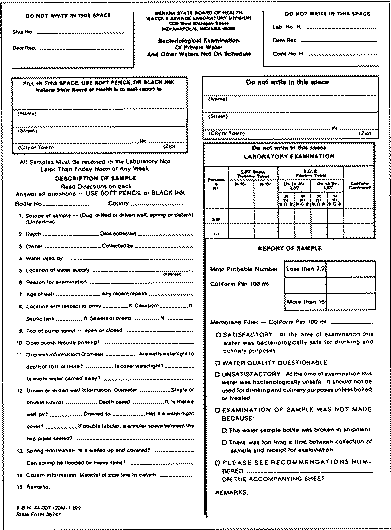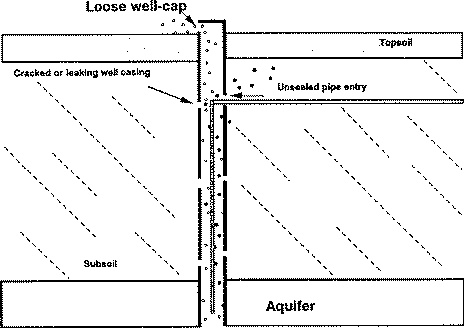
WQ-15

| MCL (Maximum Contaminant Level) | |
| Coliform Bacteria: | Less than one total coliform organism per 100 ml of water. |
| Non-coliform Bacteria: | Concentrations less than 200 organisms per 100 ml of water considered acceptable as long as the total coliform count is |
How do you know if your water is safe to drink? Appearance can be deceiving. If your water comes from a private water supply, you are responsible for monitoring its quality. One of the standard methods of checking water quality is a test for coliform bacteria; other tests include nitrate, hardness and pesticides.
With current concerns over water quality, chemical contamination (nitrate, pesticides, etc.) usually receives most of the attention. However, microbial or bacterial contamination remains the most common type of contamination. The Indiana State Board of Health (ISBH) reports from the almost 10,000 private wells tested in 1989, about 25 percent tested positive for bacterial contamination.
Estimates for the United States indicate more than 45 percent of illnesses caused by `bad water' are related to microorganisms. Data collected by the Center for Disease Control (CDC) indicates between 1971 and 1979, 37 percent of disease outbreaks were linked to microbial contamination from the overflow or seepage of sewage into ground water. Over the same time period, chemical contamination accounted for less than 10 percent of disease outbreaks.
Bacteria of many kinds occur in both soil and surface water. Bacterial numbers in soil can approach 100 million per gram of soil. One group, not commonly found in soil or water, are the fecal coliforms, that reside in high numbers in the digestive tract of all warm-blooded animals. Because they prefer the animal system, fecal coliforms typically survive less than four days in soil or water. While ground water generally contains bacteria, it should not contain any fecal coliform. When fecal coliforms are found, it suggests surface water or some waste source has directly entered the water supply. Since surface water receives frequent inputs from many sources, fecal coliforms are common and indicate recent contamination.
The presence of coliform bacteria signals the possibility of disease-causing bacteria or virus in the water. Certain fecal coliform bacteria are good indicators of pathogenic microbes since they can be identified and measured much easier than more harmful pathogens. Pathogens occur at very low levels, making testing difficult and very expensive.
When water supplies contain coliform bacteria in levels greater than one per 100 ml of water, the water may also contain pathogens that cause acute intestinal infections. While generally considered to be a discomfort to health, these infections can prove fatal for infants, the elderly and those who are ill. Water-related disease outbreaks tend to occur in the summer. Although rarely encountered today, typhoid, hepatitis and cholera, can spread through water supplies. Other sources, besides water, also transmit these diseases.
Coliform bacteria cannot be detected by direct sight, smell or taste. Private water supplies should be tested for coliform bacteria annually. Wells over 50 feet deep, and with past negative test results, can probably wait longer between tests. Bulletins WQ 3 "How To Take A Water Sample" and WQ 1 "Water Testing Laboratories" give further information on testing your water.
In some cases additional testing should be done. Repairs on a water system or well construction can allow bacteria to enter the water supply. Obtain a coliform bacteria test if any of the following occur:
- a change in color, odor or taste of the water
- flooding near the well
- repairs or changes are made to the plumbing or treatment system
- a person or animal becomes sick with a suspected water- borne disease
Two common tests for coliform bacteria use the membrane filter and the multiple tube fermentation methods. With the membrane filter method, less than one coliform bacteria per 100 ml, is a satisfactory result. A satisfactory result with the multiple tube fermentation procedure is less than 2.2 coliform bacteria per 100 ml. An example test report is shown in Figure 1.
Positive coliform bacteria test results can be listed two ways. A questionable result means possible, but uncertain, presence of bacteria. An unsatisfactory result means bacteria levels are too high.
If you receive a positive result, submit another sample. Mistakes made during collection can cause a positive result. Bacteria also tend to clump together in water and on surfaces. Several tests will give a better estimation of the bacteria level throughout the water supply.

A positive result indicates the water must be disinfected for cooking and drinking. Two common methods of disinfection are shock chlorination and continuous chlorination.
After receiving a positive result, not caused by poor sampling, shock chlorinate your water supply. Shock chlorination should always be done after digging a new well or following any water system repair work. After chlorination, submit another water sample. The water should test negative several times before use. Also, several treatments may be needed to effectively treat the entire water supply.
For highly contaminated water supplies, continuous chlorination can be used. Most public water supplies use this method as a safety measure. All surface water supplies, such as lakes, ponds or cisterns, need continuous chlorination treatment as a precaution.
Drinking and cooking water can be boiled to kill the bacteria. Distillation and ultraviolet radiation also remove coliform bacteria. Bulletin WQ 6 "Buying Home Water Treatment Equipment" explains different water treatment options.
If the water supply contains bacteria, the cause of contamination must be located. A cracked well casing or leaking wellhead allows surface water and other contaminants to enter directly into the water supply (Figure 2). Wells located close to septic systems or livestock feedlots can contain nitrate as well as coliform bacteria. A standard distance for private wells from these possible contamination sources is more than 50 feet. Shallow wells, less than 50 feet deep, or those in sandy soils, require a greater distance.
Poorly maintained water filter systems, such as activated carbon or other materials, can be a source of bacteria in the water system. Bacteria can grow on the filter and if not changed regularly, the bacteria will enter the water supply. Closely follow the guidelines provided for the filter system's upkeep.
Water from a properly located and constructed well should not contain coliform bacteria. If present, other non- bacterial contaminants could also be in your water supply. An annual test for coliform bacteria verifies the bacteriological safety of your water.

For further information on water testing or suspected contamination in your area, contact your local Health Department or county Cooperative Exten- sion office. The following bulletins in the WQ series may also be helpful:
- WQ 1 "Water Testing Laboratories"
- WQ 2 "What Is Ground Water?"
- WQ 3 "How to Take a Water Sample"
- WQ 4 "Why Test Your Water?"
- WQ 5 "Interpreting Water Test Results Part One: Inorganic Materials"
- WQ 6 "Buying Home Water Equipment"
- WQ 7 "Animal Agriculture's Effect on Water Quality Pastures and Feedlots"
- WQ 8 "Animal Agriculture's Effect on Water Quality Waste Storage"
- WQ 9 "Water Quality for Animals"
- WQ 10 "Wetlands and Water Quality"
- WQ 11 "Sulphur Water Control"
- WQ 12 "Distillation For Home Water Treatment"
"Private Water Systems Handbook," Midwest Plan Service, MWPS-14
Report any unknown source of contamination or objectionable taste, odor or color in water from a private well to: Indiana Department of Environmen- tal Management (IDEM), Ground Water Section, Indianapolis, IN 317/233-4237.
"The Bacteria Test for Drinking Water," Indiana Ground Water Protection Guidebook, IDEM.Plowman, Faye T., "Bacteria (Private Water Supply Disinfection)," Cooperative Extension Service, University of New Hampshire.
Zamani, Diana, Environmental Laboratory, Indiana State Board of Health, Indianapolis, IN.
Cooperative Extension work in Agriculture and Home Economics, state of Indiana, Purdue University, and U.S. Department of Agriculture cooperating; H. A. Wadsworth, Director, West Lafayette, IN. Issued in furtherance of the acts of May 8 and June 30, 1914. The Cooperative Extension Service of Purdue University is an affirmative action/equal opportunity institution.